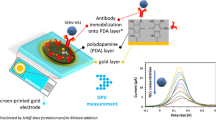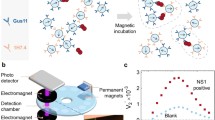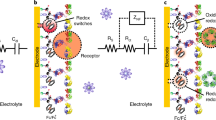Abstract
Non-structural 1 (NS1) is a protein biomarker that can be found in blood in the early stages of dengue and related infections (Zika and Chikungunya). This study aims to develop a biosensor to selectively quantify NS1 using DNA aptamer co-immobilized on gold electrodes with 6-(ferrocenyl)hexanethiol (FCH) using electrochemical capacitive spectroscopy. This technique uses a redox probe (FCH) immobilized on the self-assembled monolayer to convert impedance into capacitance information. The developed platform was blocked with bovine serum albumin before NS1 exposure and the ratio between aptamers and FCH was optimized. The aptasensor was tested using commercial NS1 serotype 4 in phosphate-buffered saline and commercial undiluted human serum. Using the optimum applied potential provides high sensitivity (3 and 4 nF per decade) and low limit of detection (30.9 and 41.8 fg/mL) with a large linear range (10 pg to 1 µg/mL and 10 pg to 100 ng/mL, respectively). Both results exhibit a residual standard deviation value < 1%. The results suggested that this aptasensor was capable of detecting NS1 in the clinical range and can be applied to any other specific aptamer with FCH, opening the path for label-free miniaturized point-of-care devices with high sensitivity and specificity.
Graphical Abstract






Similar content being viewed by others
Data availability
The data that support the findings of this article are available from the authors upon request.
References
Ten health issues WHO will tackle this year. https://www.who.int/news-room/feature-stories/ten-threats-to-global-health-in-2019. Accessed 16 Apr 2020
Redoni M, Yacoub S, Rivino L et al (2020) Dengue: status of current and under-development vaccines. Rev Med Virol e2101. https://doi.org/10.1002/rmv.2101
Bhatt S, Gething PW, Brady OJ et al (2013) The global distribution and burden of dengue. Nature 496:504–507. https://doi.org/10.1038/nature12060
Guzman MG, Halstead SB, Artsob H et al (2010) Dengue: a continuing global threat. Nat Rev Microbiol 8:S7–S16. https://doi.org/10.1038/nrmicro2460
de GóesCavalcanti LP, Freitas ARR, Brasil P, da Cunha RV (2017) Surveillance of deaths caused by arboviruses in Brazil: from dengue to chikungunya. Mem Inst Oswaldo Cruz 112:583–585. https://doi.org/10.1590/0074-02760160537
Atualização Epidemiológica Dengue, chikungunya e Zika -25 de janeiro de 2023 - OPAS/OMS | Organização Pan-Americana da Saúde. https://www.paho.org/pt/documentos/atualizacao-epidemiologica-dengue-chikungunya-e-zika-25-janeiro-2023. Accessed 7 Jul 2023
Halstead SB, Russell PK, Brandt WE (2020) NS1, Dengue’s dagger. J Infect Dis 221:857–860. https://doi.org/10.1093/infdis/jiz083
Foley DA, Yeoh DK, Karapanagiotidis T et al (2020) Fever in the returned traveller: the utility of the Platelia Dengue NS1 antigen enzyme immunoassay for the diagnosis of dengue in a non-endemic setting. Pathology (Phila) 52:370–372. https://doi.org/10.1016/j.pathol.2020.01.438
Villalonga A, Pérez-Calabuig AM, Villalonga R (2020) Electrochemical biosensors based on nucleic acid aptamers. Anal Bioanal Chem 412:55–72. https://doi.org/10.1007/s00216-019-02226-x
Teoh B-T, Sam S-S, Tan K-K et al (2016) The Use of NS1 Rapid diagnostic test and qRT-PCR to complement IgM ELISA for improved dengue diagnosis from single specimen. Sci Rep 6:1–8. https://doi.org/10.1038/srep27663
Alcon S, Talarmin A, Debruyne M et al (2002) Enzyme-linked immunosorbent assay specific to dengue virus type 1 nonstructural protein NS1 reveals circulation of the antigen in the blood during the acute phase of disease in patients experiencing primary or secondary infections. J Clin Microbiol 40:376–381. https://doi.org/10.1128/JCM.40.02.376-381.2002
Cecchetto J, Fernandes FCB, Lopes R, Bueno PR (2017) The capacitive sensing of NS1 Flavivirus biomarker. Biosens Bioelectron 87:949–956. https://doi.org/10.1016/j.bios.2016.08.097
Lee KH, Zeng H (2017) Aptamer-based ELISA assay for highly specific and sensitive detection of Zika NS1 protein. Anal Chem 89:12743–12748. https://doi.org/10.1021/acs.analchem.7b02862
Jia M, Sha J, Li Z et al (2020) High affinity truncated aptamers for ultra-sensitive colorimetric detection of bisphenol A with label-free aptasensor. Food Chem 317:126459. https://doi.org/10.1016/j.foodchem.2020.126459
Bachour Junior B, Batistuti MR, Sanches Pereira A et al (2021) Electrochemical aptasensor for NS1 detection: towards a fast dengue biosensor. Talanta 233:122527. https://doi.org/10.1016/j.talanta.2021.122527
Keighley SD, Li P, Estrela P, Migliorato P (2008) Optimization of DNA immobilization on gold electrodes for label-free detection by electrochemical impedance spectroscopy. Biosens Bioelectron 23:1291–1297. https://doi.org/10.1016/j.bios.2007.11.012
Benites TA, Ribeiro WC, Góes MS et al (2014) Effects of surface roughness on properties of passivation of self-assembled organic monolayers. Quím Nova 37:1533–1537. https://doi.org/10.5935/0100-4042.20140241
Trasatti S, Petrii OA (1991) Real surface area measurements in electrochemistry. Pure Appl Chem 63:711–734. https://doi.org/10.1351/pac199163050711
Wong LCC, Jolly P, Estrela P (2018) Development of a sensitive multiplexed open circuit potential system for the detection of prostate cancer biomarkers. BioNanoScience 8:701–706. https://doi.org/10.1007/s12668-017-0408-0
Fernandes FCB, Góes MS, Davis JJ, Bueno PR (2013) Label free redox capacitive biosensing. Biosens Bioelectron 50:437–440. https://doi.org/10.1016/j.bios.2013.06.043
Wang L, Veselinovic M, Yang L et al (2017) A sensitive DNA capacitive biosensor using interdigitated electrodes. Biosens Bioelectron 87:646–653. https://doi.org/10.1016/j.bios.2016.09.006
Singh NK, Arya SK, Estrela P, Goswami P (2018) Capacitive malaria aptasensor using Plasmodium falciparum glutamate dehydrogenase as target antigen in undiluted human serum. Biosens Bioelectron 117:246–252. https://doi.org/10.1016/j.bios.2018.06.022
Ulman A (1996) Formation and structure of self-assembled monolayers. Chem Rev 96:1533–1554. https://doi.org/10.1021/cr9502357
Marchante E, Crivillers N, Buhl M et al (2015) An electrically driven and readable molecular monolayer switch based on a solid electrolyte. https://doi.org/10.1002/ange.201508449
Rivera IM, Cabrera CR (1993) Mass measurements of ferrocene adsorption at gold films with the electrochemical quartz crystal microbalance. J Electrochem Soc 140:L36–L38. https://doi.org/10.1149/1.2056183
Auletta T, van Veggel FCJM, Reinhoudt DN (2002) Self-assembled monolayers on gold of ferrocene-terminated thiols and hydroxyalkanethiols. Langmuir 18:1288–1293. https://doi.org/10.1021/la011474u
Kleinjung F, Klussmann S, Erdmann VA et al (1998) High-affinity RNA as a recognition element in a biosensor. Anal Chem 70:328–331. https://doi.org/10.1021/ac9706483
Armbruster DA, Pry T (2008) Limit of blank, limit of detection and limit of quantitation. Clin Biochem Rev 29:S49–S52
Chen Y, Maguire T, Hileman RE et al (1997) Dengue virus infectivity depends on envelope protein binding to target cell heparan sulfate. Nat Med 3:866–871. https://doi.org/10.1038/nm0897-866
Funding
BBJ was financed by the Coordenação de Aperfeiçoamento de Pessoal de Nível Superior/Brasil (CAPES—Finance Code 001). MRBS received funding from FAPESP (2013/26133–7) and Conselho Nacional de Desenvolvimento Científico e Tecnológico (151658/2022–6). MM received funding from FAPESP (2017/24201–6) and CNPq (308713/2018–4 and 310405/2021–1).
Author information
Authors and Affiliations
Contributions
BBJ carried out the experimental work under the supervision of MRB and MM. MRB and BBJ wrote the paper with contributions from MM. All authors checked and approved the final manuscript.
Corresponding author
Ethics declarations
Conflict of interest
The authors declare no competing interests.
Additional information
Publisher's Note
Springer Nature remains neutral with regard to jurisdictional claims in published maps and institutional affiliations.
Supplementary Information
Below is the link to the electronic supplementary material.
Rights and permissions
Springer Nature or its licensor (e.g. a society or other partner) holds exclusive rights to this article under a publishing agreement with the author(s) or other rightsholder(s); author self-archiving of the accepted manuscript version of this article is solely governed by the terms of such publishing agreement and applicable law.
About this article
Cite this article
Bachour Junior, B., Batistuti Sawazaki, M.R. & Mulato, M. Electrochemical capacitive dengue aptasensor using NS1 in undiluted human serum. Microchim Acta 191, 72 (2024). https://doi.org/10.1007/s00604-023-06141-y
Received:
Accepted:
Published:
DOI: https://doi.org/10.1007/s00604-023-06141-y




